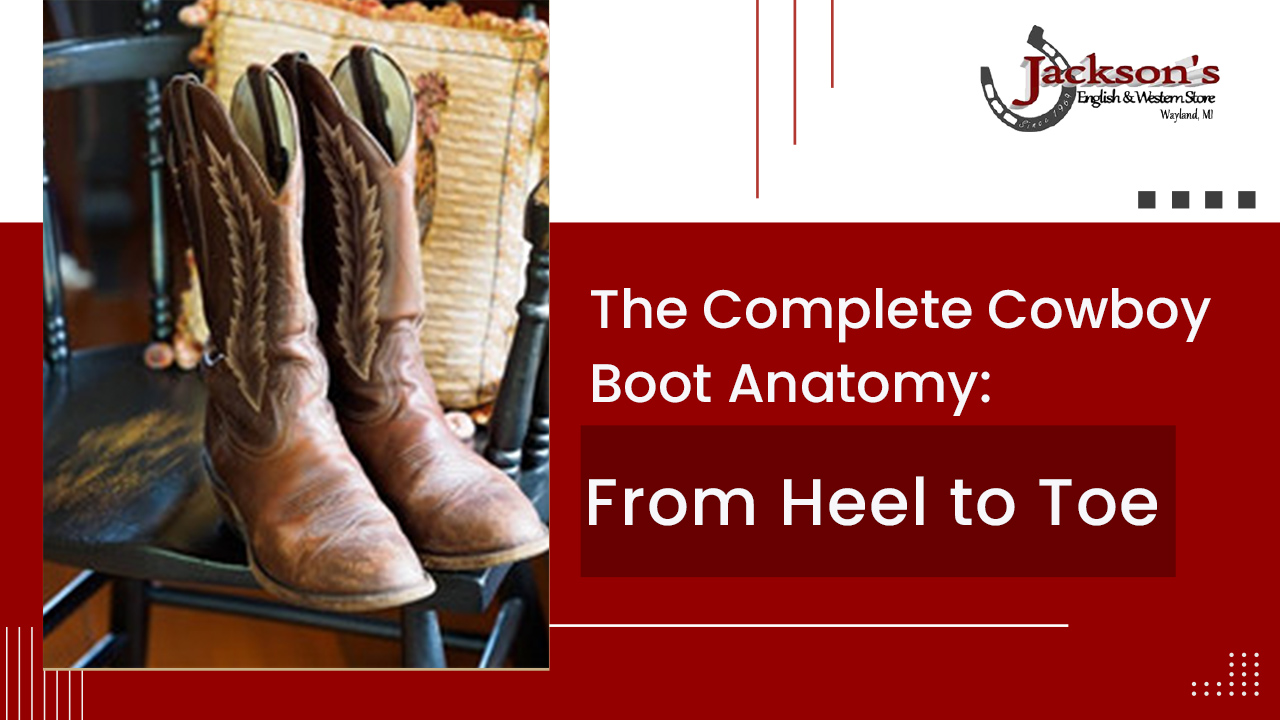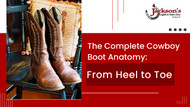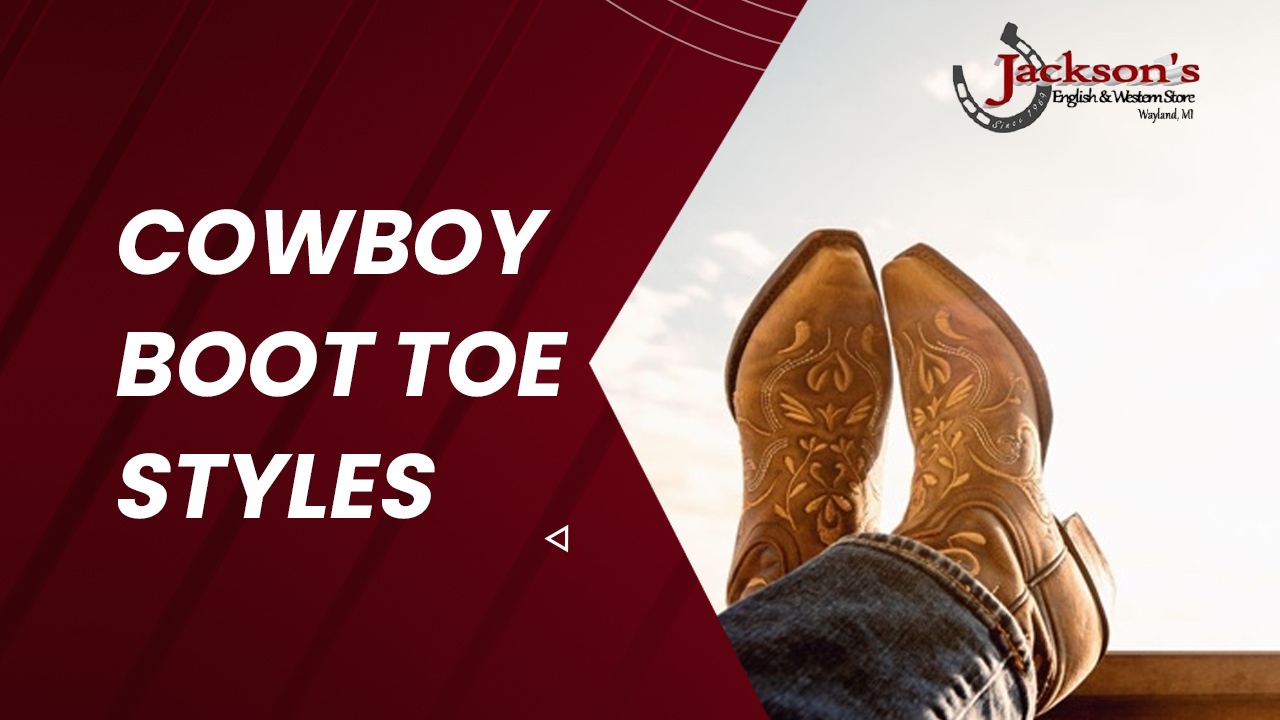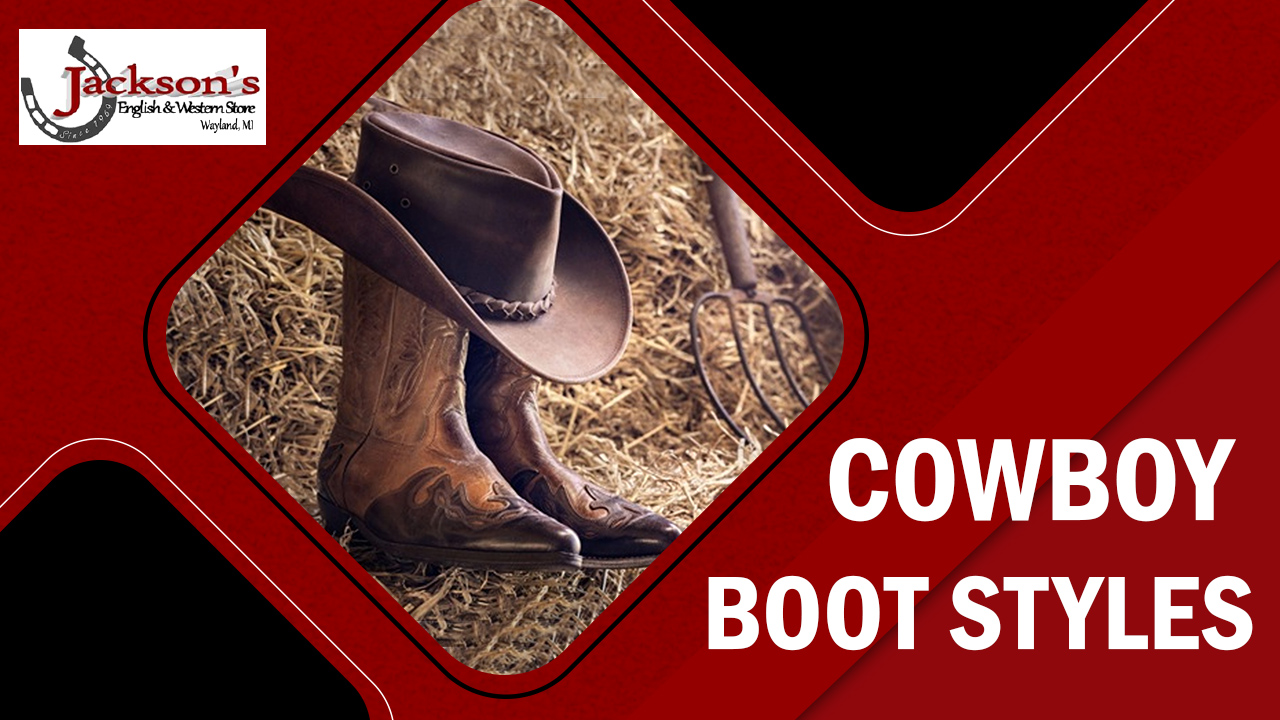The Complete Cowboy Boot Anatomy: From Heel to Toe
Posted by Jackson's Western Store on Feb 21, 2023

You probably know a “cowboy boot” as soon as you see it. But if you’re not familiar with this unique fusion of form and fashion, some of the details might not yet be apparent to you.
Think about that the next time you visit a western store and are immersed among the countless different styles in cowboy boots - there’s a lot more variety than most think.
So, with no further ado, let’s get into the nitty-gritty.
Cowboy Boot Anatomy: A Look at the Vital Parts
First things first, all different styles of cowboy and western boots have some features in common. Among them are the following:
- Quarter: A boot’s quarters (front and back) are the two leather panels that make up the shaft of the boot. Often, the quarters are elaborately decorated with piping or special contrasting stitching, known as quarter stitching. Western boots are unique in that they have a shaft that lacks laces, as laces constitute an occupational hazard while riding a horse.
- Vamp: The vamp is that part of the cowboy boot anatomy that covers the top and sides of the foot as well as the toe.
- Heel: Western boots are defined by what is known as a “stacked” or “Cuban” heel. The taller, angled, underslung heel makes it easier to grip the stirrups while riding and presents less of a risk of the foot sliding too far forward.
- Insole: Many traditional western boots were made with a lining and insole of leather, as leather is flexible and conforms to the wearer’s contours over time. Many western boots still feature leather linings and insoles, though some may be made with modern materials.
- Outsole: Most western boots are made with slick leather outsoles that, while slippery on some surfaces, are easier to insert into the stirrup without hanging up. This is a unique feature that makes western boots well-adapted to riding.
- Welt: A boot’s welt is the strip of leather that lays between the upper and the outsole, through which the sole’s stitching runs.
- Stitching/Piping: Many Western boots feature intricate decorations with contrasting stitching/piping. Piping is the ornamental stitching or seaming that goes along the edge of the shaft, providing style and securing the shaft.
- Toe: The part of a cowboy boot that contains the toe box is known as the toe or toe medallion. Western boots come in a variety of toe styles.
- Counter: The rear bottom section of the cowboy boot anatomy offers support for the heel. Improve strength by incorporating a heel counter.
- Instep: The upper part of the boot that covers the foot. A properly designed arch support guarantees a snug and comfortable fit, avoiding any movement of the foot within the shoe.
- Last: A foot-shaped mold is utilized in the construction of boots to determine the fit and structure, ultimately impacting comfort and support.
- Toe Box: It is the rigid material located at the front of the boot. It is sandwiched between the outer leather and liner, which helps preserve its shape and enhance longevity.
- Midsole: Midsole is the part located between the insole and outsole. It is responsible for shock absorption and providing foot cushioning. Frequently crafted from leather to provide both comfort and longevity.
- Pull Strap: Rings at the top of the boot shaft that aid in putting on the boot, simplifying the process of wearing.
Cowboy Boot Toe Styles
The following are some of the more common styles in cowboy boot toes.
- Classic: The classic toe is also known as the R toe and is slightly pointed, but not as sharply as a designated “pointed toe.” The classic toe style is a good all-purpose option and is suitable for riding while remaining comfortable for walking.
- Pointed: The pointed toe, also known as the J toe, is one of the most common toe styles you will find in western boots. It is a sharply pointed toe that is designed for comfort and practicality when horseback riding, as the pointed toe is easy to insert into a stirrup.
- Snip: The snip toe is also known as a D or N toe, and is a variation of the pointed toe; snip toes are pointed toes with the very tip squared off.
- Round: The round toe, which is just what it sounds like, is also known as a U toe or roper toe. More rounded than a pointed toe, the round toe is a very comfortable style of toe that is suitable for walking and work.
- Square and broad square: The square toe, also known as the French toe, is squared off at the end, which allows the toes more room to spread out. A variation of the square toe is the broad square, which is just a wider version. This creates a roomier, more stable, more comfortable boot. Many western-style workboots have square toes.
- Cutter: Boots with a cutter toe are like square-toed boots, but are narrower. Think of them as a cross between a snip toe and a square toe. They don’t have quite the same amount of room as a square-toe boot, but have more room than pointed toes.
Cowboy Boot Styles
Cowboy boots vary in more than just toe style. Some of the more common styles in cowboy boots are as follows.
- Traditional western boots: Traditional cowboy boots have a tall Cuban heel and laceless shafts 12” tall. They typically have round or pointed toes and slick leather soles that make them perfect for horseback riding.
- Roper boots: Roper boots were designed to be supportive and comfortable when “roping,” and wrangling calves. They are shorter than traditional western boots and have more support around the ankle. They typically have shorter heels and rounded or pointed toes.
- Buckaroo boots: Buckaroo boots are among the showiest of western boot styles, with shafts that are typically between 14 and 17 inches high. They also have tall angled heels and are often ornately stitched. Buckaroo boots usually have pointed or rounded toes but may have square toes. Buckaroo boots also typically have holes or grips at the sides of the top of the shafts which make it easier to pull them on.
- Stockman boots: Stockman boots are a variation on classic western boots, preserving the high shaft and often the elaborate stitching; but they often have lower heels, better arch support, and grippier rubber outsoles which offer better traction. These sorts of western boots are great for walking, work, and everyday wear.
- Western-style workboots: Last but not least we have western-style workboots, which, though they may look like classic cowboy boots, are enhanced with safety features that protect workers on ranches and in industrial settings. Western-style workboots are often laceless, with wide square toes; they typically are waterproof and insulated, feature electrical protection, and are made with steel or composite toes and durable rubber outsoles that provide excellent traction in adverse conditions.
Come Visit Our Western Store to Learn More
Interested in getting an expert’s take on the many different styles of western boots there are available? Come on down to our western store in Wayland, Michigan and one of our knowledgeable, helpful crew would be more than happy to give you a crash course in western clothing and boot styles.
And if you’re thinking about getting a pair, there’s an even better reason for a visit - each western boot purchase made in-store is eligible for free fitting, stretching, and break-in services, on the house!



